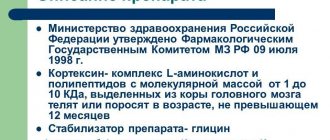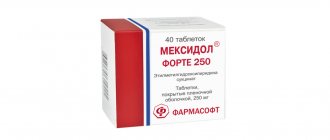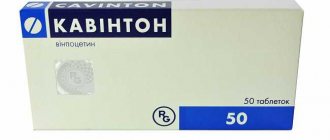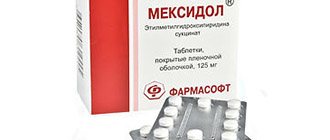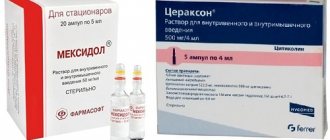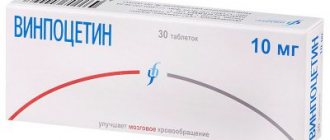Mexidol® (Mexidolum®)
IM or IV (stream or drip).
When administered by infusion, the drug should be diluted in 0.9% sodium chloride solution.
Mexidol® is injected slowly over 5-7 minutes in a stream, and dropwise at a rate of 40-60 drops per minute. The maximum daily dose should not exceed 1200 mg.
For acute cerebrovascular accidents
Mexidol® is used in the first 10-14 days - 200-500 mg IV drip 2-4 times a day, then 200-250 mg IM 2-3 times a day for 2 weeks.
For traumatic brain injury and consequences of traumatic brain injury
Mexidol® is used for 10-15 days intravenously at a dose of 200-500 mg 2-4 times a day.
For dyscirculatory encephalopathy in the decompensation phase
Mexidol® should be prescribed intravenously in a stream or drip at a dose of 200-500 mg 1
-
2 times a day for 14 days. Then IM 100-250 mg/day. over the next 2 weeks.
For course prophylaxis of dyscirculatory encephalopathy
the drug is administered intramuscularly at a dose of 200-250 mg 2 times a day for 10-14 days.
For mild cognitive impairment in elderly patients and anxiety disorders
the drug is used intramuscularly at a daily dose of 100-300 mg/day for 14-30 days.
In acute myocardial infarction as part of complex therapy
Mexidol® is administered intravenously or intramuscularly for 14 days, against the background of traditional therapy for myocardial infarction, including nitrates, beta-blockers, angiotensin-converting enzyme (ACE) inhibitors, thrombolytics, anticoagulant and antiplatelet agents, as well as symptomatic agents according to indications.
In the first 5 days, to achieve maximum effect, it is advisable to administer the drug intravenously; in the next 9 days, Mexidol® can be administered intramuscularly. Intravenous administration of the drug is carried out by drip infusion, slowly (to avoid side effects) in a 0.9% sodium chloride solution or 5% dextrose (glucose) solution in a volume of 100-150 ml for 30-90 minutes. If necessary, a slow jet injection of the drug, lasting at least 5 minutes, is possible.
The drug is administered (intravenous or intramuscular) 3 times a day, every 8 hours. The daily therapeutic dose is 6-9 mg/kg body weight per day, a single dose is 2-3 mg/kg body weight. The maximum daily dose should not exceed 800 mg, single dose - 250 mg.
For open-angle glaucoma of various stages as part of complex therapy
Mexidol® is administered intramuscularly at 100-300 mg/day, 1-3 times a day for 14 days.
For alcohol withdrawal syndrome
Mexidol® is administered in a dose of 200-500 mg intravenously or intramuscularly 2-3 times a day for 5-7 days.
In case of acute intoxication with antipsychotic drugs
the drug is administered intravenously at a dose of 200-500 mg/day for 7-14 days.
In acute purulent-inflammatory processes of the abdominal cavity (acute necrotizing pancreatitis, peritonitis)
the drug is prescribed on the first day both in the preoperative and postoperative periods. The administered doses depend on the form and severity of the disease, the prevalence of the process, and variants of the clinical course. The drug should be discontinued gradually only after a stable positive clinical and laboratory effect.
For acute edematous (interstitial) pancreatitis
Mexidol® is prescribed 200-500 mg 3 times a day, intravenously (in 0.9% sodium chloride solution) and intramuscularly.
Mild severity of necrotizing
pancreatitis
- 100-200 mg 3 times a day intravenously (in 0.9% sodium chloride solution) and intramuscularly.
Moderate severity
- 200 mg 3 times a day, intravenously (in 0.9% sodium chloride solution).
Severe course
— in a pulse dosage of 800 mg on the first day, with a two-time administration regimen; then 200-500 mg 2 times a day with a gradual reduction in the daily dose.
Extremely severe course
- at an initial dosage of 800 mg/day until the manifestations of pancreatogenic shock are persistently relieved, upon stabilization of the condition, 300-500 mg 2 times a day intravenously (in 0.9% sodium chloride solution) with a gradual decrease in the daily dosage.
Top 16 drugs that can leave you without a driver's license
Attention! Not all medicines directly contain a substance recognized as a narcotic in Russia. However, many substances contained in these medications, when broken down in the body, can form derivative substances included in the list of prohibited substances. Therefore, prohibited substances may be detected in a person’s urine or blood during a medical examination.
As a result of exceeding their threshold value, the driver may be considered to be under the influence of drugs. Also, a number of medications can give a false positive result for narcotic and psychotropic substances when testing urine or blood.
"Nurofen plus"
substance: codeine
"Coldrex Knight"
substance: phenylephrine
3. "Lorraine"
substances: chlorphenamine and phenylephrine
"Hexapneumin"
substances: chlorphenamine and guaifenesin
5. "Fervex"
substance: pheniramine
6. Teraflu
substance: phenylephrine
"Kodelanov"
substance: codeine
The drug is currently available only with a doctor's prescription!
"Tetralgin"
substance: Codeine, phenobarbital
"Pentalgin-N"
substances: codeine, phenobarbital
10. "Ketanov"
substance: ketorolac tromethamine
"Solpadeine"
substance: codeine
12. "Caffetin"
substance: codeine phosphate sesquihydrate
"Terpincode"
substance: codeine
14. "Tavegil"
substance: clemastine hydrofumarate
It should not be taken due to drowsiness that may occur after taking the medicine.
"Valoserdin" ("Corvalol", "Valocordin")
substances: phenobarbital, ethyl bromoisovalerianate (ethyl ester of bromoisovaleric acid)
Spray for runny nose "Tizin"
substances: xylometazoline hydrochloride, benzyl alcohol; benzalkonium chloride; disodium edetate; hydrochloric acid; sorbitol; sodium citrate; methylhydroxypropylcellulose; polyoxyethylene glycerol trihydroxystearate 40; purified water; perfume oil.
Warning: This medication may cause a false-positive drug test result.
It is worth noting that not in all cases, drivers using the above medications can be recognized as intoxicated based on the results of a medical examination. The fact is that, according to current legislation, narcotic or psychotropic substances detected in urine or blood tests must exceed established threshold values. We have already raised this topic in detail (you can read it here).
These tables are:
Indications for use
The following indications for use of Mexidol in the form of a solution are distinguished:
- acute cerebrovascular accidents;
- traumatic brain injuries;
- manifestations of vegetative dystonia;
- open-angle glaucoma;
- anxiety and neurosis-like conditions;
- withdrawal syndrome due to alcohol abuse;
- drug intoxication;
- hypertonic disease;
- migraine-type headache;
- myocardial infarction in the acute phase.
Mexidol is prescribed as part of complex therapy for acute purulent lesions of the abdominal cavity requiring surgical intervention. This is, for example, acute pancreatic necrosis, peritonitis.
Indications for the tablet form of the drug are:
- consequences of cerebrovascular accidents;
- mild form of traumatic brain injury, as well as consequences;
- encephalopathy of various origins;
- as part of complex therapy of diseases of the cardiovascular system;
- asthenia;
- long-term exposure to psycho-emotional factors.
Mexidol for VSD
The indication for the use of Mexidol injections is vegetative-vascular dystonia. The drug helps improve blood circulation. As a result, headaches and dizziness are relieved. The dosage is selected individually depending on the severity of symptoms.
Mexidol for hypertension
The drug is part of the complex therapy of arterial hypertension. Mexidol normalizes metabolic processes that take part in the functioning of the cardiovascular system. The drug improves blood circulation, helping to stabilize blood pressure.
Mexidol for panic attacks
The drug has antihypoxic, nootropic and stress-protective effects. As a result, brain activity normalizes and the severity of anxiety symptoms decreases.
Mexidol for epilepsy
The anticonvulsant effect of the drug allows its use in the complex treatment of epilepsy. Mexidol normalizes cerebral circulation, improves thinking and memory processes. The dosage is determined by the attending physician depending on the severity of the condition.
Mexidol for oncology
Mexidol is included in the complex therapy of oncopathologies due to its antioxidant effect. The decision about the need to prescribe the drug is made by the attending physician. Some tumor formations exclude the possibility of taking Mexidol.
Mexidol for migraines
The disease tends to periodically worsen. Mexidol is used to prevent migraine-type headaches. The drug improves blood microcirculation processes in the brain area.
Mexidol for stroke
Cerebrovascular accidents and their consequences are included in the list of indications for taking the drug. Mexidol is used both in the acute period and as a prevention of relapse. Indications for the use of the drug in tablets are preliminary injection therapy.
Mexidol for multiple sclerosis
Used as part of complex therapy. Improves cerebral circulation, helps normalize cognitive functions.
A case from practice: how people are deprived of their rights for using conventional drugs
Do you think this won't affect you? In vain. Every year in Russia, thousands of drivers who get behind the wheel after using seemingly harmless medications are deprived of their licenses.
Moreover, many do not agree with the decisions of lower courts, challenging the deprivation of rights. But, unfortunately, in most cases the courts side with medical laboratories and traffic police authorities.
Here is an example from judicial practice, when a driver was deprived of his license for using Teraflu, Tizin, a spray for the common cold.
Here is a link to the judicial act.
What other medications should a driver not take?
Please note that we have included in our list only a small part of the medications that can give positive results when tested for narcotic and toxicological substances.
In addition, we remind you that there are a number of medications that, when taken, cause drowsiness and also affect a person’s reaction. Typically, in the instructions for such medications, the manufacturer warns about the effect of the medication on the ability to drive a car.
As you already understand, if you are taking such medications (for example, the antiallergic drug Suprastin), you should not drive, as they can affect vehicle control. First of all, you should not drive a car while drowsy. This is directly prohibited by clause 2.7 of the Russian Traffic Regulations.
What determines the duration of depression in alcoholism?
One of the most pressing questions is how long does depression last after heavy drinking? First of all, it depends on the severity of depression from a hangover. In acute alcohol withdrawal syndrome, severe somatic, autonomic and neurological disorders are observed. In this state, depression is often combined with increased irritability, anxiety and hysteria. Anxiety usually lasts 2-3 days, but depression after heavy drinking, accompanied by melancholy and self-blame, is more stable and lasts for 1-2 weeks.
What is primary in the occurrence of anxiety-depressive syndrome – depression or alcoholism?
In this couple of diseases, it is difficult to determine what was the root cause - depression or alcoholism. Their cause-and-effect relationship is often implicit. It all depends on the specific case. Quite often, a person in a stressful situation reaches for a glass of alcohol as a lifeline. Stress can be caused by various circumstances - conflicts at work and in the family, loss of income, death of loved ones, social problems and even a simple quarrel in transport. The more unexpected the negative event, the stronger the stress state it causes.
On the other hand, it is known that chronic alcoholism causes a failure of the “stress” system, similar to depressive states with increased release of corticotropin and activation of the hypothalamic-pituitary system. It is corticotropin that is responsible for increasing the formation of cortisol in the adrenal glands, which is responsible for loss of appetite, the emergence of a subjective feeling of anxiety, immunosuppression and increased inflammatory reactions. These changes prolong depression after alcohol abstinence for up to four weeks. When alcoholism and depression are combined, the risk of their occurrence doubles, and long-term use of large doses of ethanol increases the risk of developing depression, suicide attempts and anxiety by 40%.
By the way, a huge role in the development of depression and alcohol addiction belongs to the common hereditary factor. It is responsible for 35-60% of the occurrence of these diseases.
Acupuncture treatment is an effective way to get rid of alcohol addiction in the early stages of the disease.

